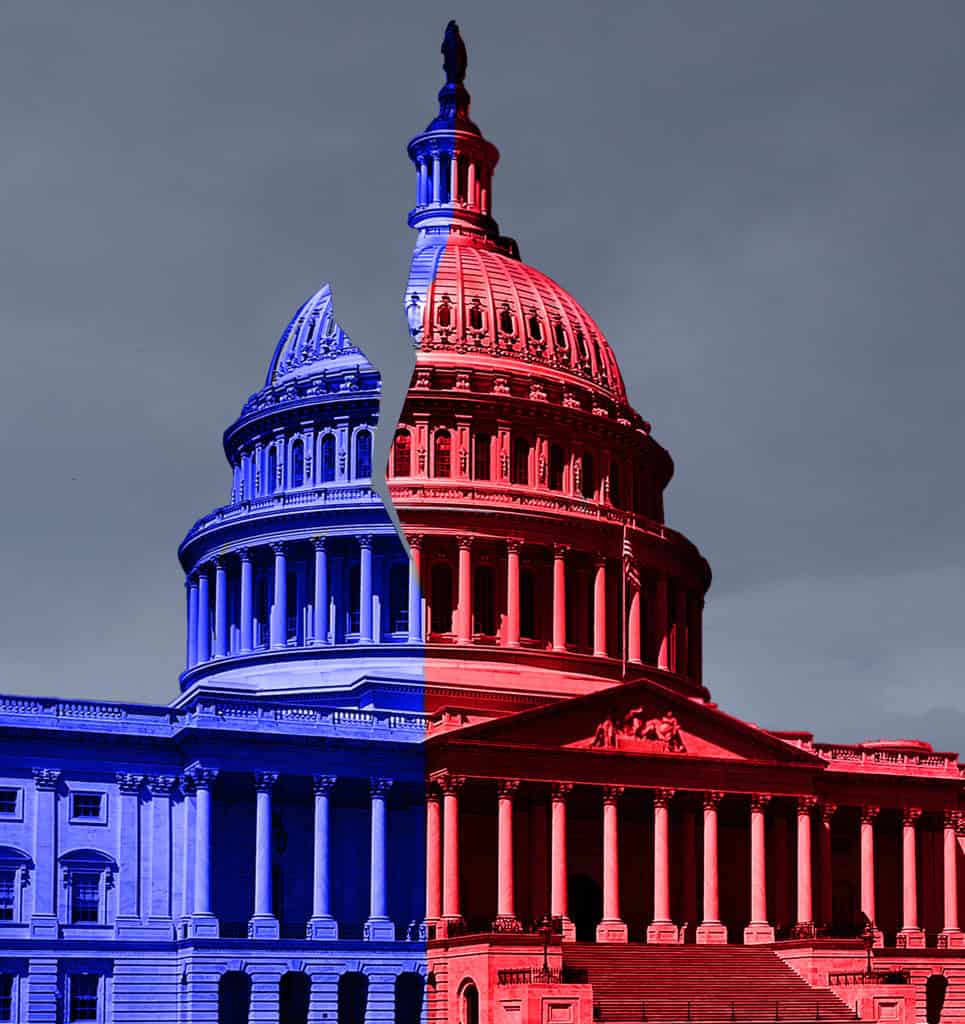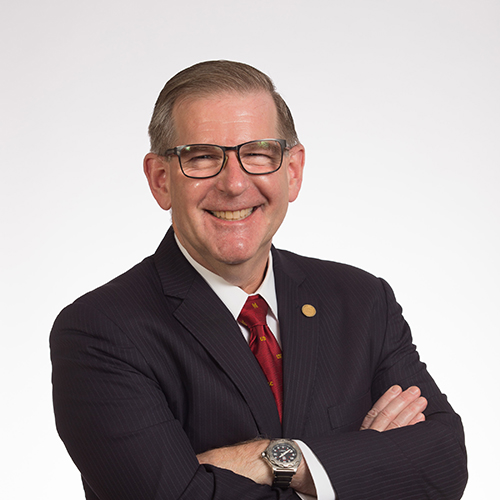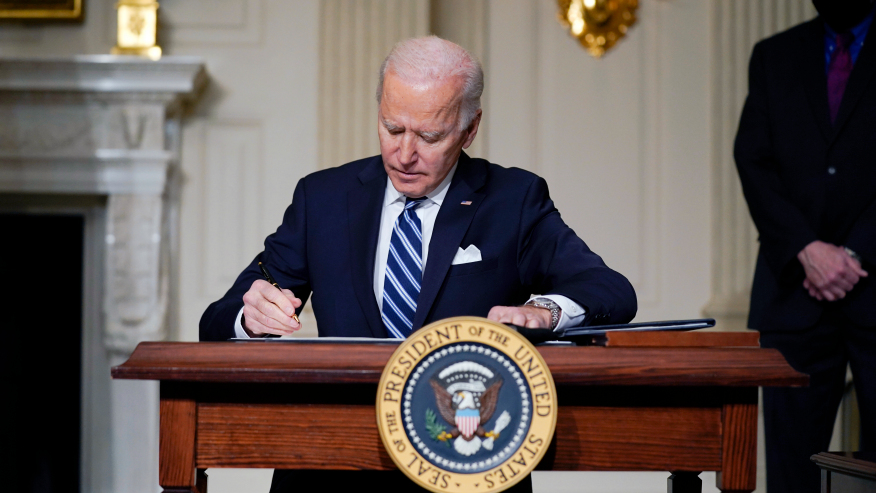By Cristy Lytal

President Joe Biden’s administration recently passed the halfway point of the “100 days” period, during which newly seated presidents seek to deliver on key campaign promises. On day 50, the President signed a $1.9 trillion stimulus and COVID-19 relief package—a boon to millions of Americans in need of assistance. However, despite the bill’s passage in both houses of Congress, USC Price experts share that this does not necessarily signal a new era of Congressional cooperation.
So far, the president has relied heavily on executive orders and actions to reverse policies of his predecessor, aiming to promote equity, condemn harsh immigration enforcement, call for common-sense gun control, take action on the climate crisis, and lead a coordinated response to the pandemic. But when it comes to the traditional legislative process, Biden faces a Congress that is severely divided.
Jeffery A. Jenkins, a faculty member at the USC Price School of Public Policy who studies U.S. political institutions and the policy process, predicts a difficult four years for Biden, with little or no traction on the Green New Deal, gun control, health care coverage, or social welfare policies. And Senator Bernie Sanders’s bid for a $15 minimum wage has already failed to pass the Senate, with eight Democrats and all 50 Republicans voting against it.

Provost Professor of Public Policy, Political Science, and Law
Judith & John Bedrosian Chair of Governance and the Public Enterprise
Director, Bedrosian Center
Director, PIPE Collaborative
“Our system of government is not set up to do big things, unless you have super majorities,” said Jenkins, Provost Professor of Public Policy, Political Science, and Law, and the Judith & John Bedrosian Chair of Governance and the Public Enterprise at USC Price. “Even something that would only require a bare majority…is something that [the Democrats] would have to figure out how to get somebody from a purple state like Arizona (Sinema), or a deeply red state like West Virginia (Manchin), on board.”
Still, Jenkins sees a chance to build coalitions around moderate policies related to transportation, trade, agriculture, and possibly sentencing reform—as well as the next item on Biden’s legislative agenda: immigration.
As a USC Professor of Journalism and Public Policy who specializes in immigration policy, Roberto Suro minces no words in stating that Biden has inherited “a complicated mess.” This includes a gutted immigration system and a backlog of more than a million asylum cases, including a vast number from Guatemala, Honduras and El Salvador.
“In terms of specific government policies and the workings of government, the Trump administration was probably more consequential on immigration than really any other field,” said Suro. “There’s a count of at least 500 separate executive actions on immigration that need to be addressed somehow or another, and they’re intersecting, layered, and very much down into the nuts and bolts of the system. It was a deliberate wrecking approach.”

Professor
Associate Director, USC Sol Price Center for Social Innovation
Instead of attempting to undo all of these individual orders, Biden has proposed a comprehensive bill that provides a path to citizenship for the estimated 11 million illegal immigrants currently living in the U.S.
“The ideal would be to create statutory fixes and remake the system in a more intelligent way,” said Suro. “The question: Is that politically feasible? With a 50-50 Senate, it’s very, very difficult. With a filibuster, it’s really impossible to see how you do it. So then the Democrats will face the choice of whether they pull the plug on the filibuster or not, because that’s what it would take in order to produce a sweeping statutory fix.”
Regardless of the fate of the filibuster, one policy area is notably one of consensus: trade policy.
According to Geraldine Knatz, Professor of the Practice of Policy and Engineering at USC and former Executive Director of the Port of Los Angeles, “Generally, trade policies that help our ports and economy tend to have a greater chance of bipartisan support. You saw that happen with the renewal of the NAFTA agreement.”
It remains to be seen whether Biden will attempt to renegotiate the Comprehensive and Progressive Agreement for Trans-Pacific Partnership—the existing trade agreement among 11 Pacific Rim countries. Former president Donald J. Trump withdrew from the negotiating table on his first day in office in 2017, leaving the remaining 11 countries free to revise the agreement without respect to U.S. priorities related to the protection of intellectual property, the environment and labor.

Professor of the Practice of Policy and Engineering
“Biden faces a key challenge in July when the Trade Promotion Authority expires,” said Knatz. “He will need that authority renewed so he can negotiate trade agreements.”
Another major policy issue is the trade war with China, and Biden appears to be taking a measured approach.
“He supports trade liberalization, so I don’t think he’ll be imposing tariffs like Trump did,” said Knatz. “However, he didn’t immediately pull back on them either. He probably will be taking a second look at all of them, and what the pluses and minuses were.”
Democrats and Republicans may also be able to agree about ensuring funding for the Highway Trust Fund, which has been struggling with insolvency for years.
Biden’s new transportation secretary Pete Buttigieg has signaled that it might be time to rethink how we fund the interstate highway system by adopting a new “vehicle miles traveled” or VMT tax, which would be based on drivers’ actual road mileage.

Professor
As an expert in transportation and economics, faculty member James E. Moore, II, believes that VMT charges make sense, especially given the phase out of fossil fuels.
“We pay for road space with fuel taxes, both at the state and the federal level,” said Moore, who is a Professor of Industrial and Systems Engineering, Policy, Planning and Development, and Civil and Environmental Engineering at USC. “We will need an alternative financing mechanism, and right now, it doesn’t exist.”
But policymaking isn’t the only important work that needs to be done. The decimated civil service field is another element of leading the country forward that the Biden administration would be remiss in ignoring.
“A lot of career civil servants left government during the Trump years and/or were pushed out,” said Jenkins. “One might say an intended ‘hollowing out’ occurred.”
The Civil Service began hemorrhaging employees well over a decade ago. Between 2008 and 2020, 10% or more of the civil service exited federal agencies, including the departments of State, Justice, Agriculture, the Interior, the Treasury, and Housing and Urban Development.
Morale at these agencies is also at an all-time low: nearly 60% of federal government employees agree or strongly agree with the statement that “an inadequately skilled workforce is a significant obstacle to my agency fulfilling its core mission,” according to a recent survey conducted by researchers from Vanderbilt University, Georgetown University, and the Partnership for Public Service.

C.C. Crawford Professor in Management and Performance and Associate Professor
Compounding the crisis, it’s expected that 30% of the federal workforce will be eligible to retire by 2023, and many more have expressed intentions to leave their jobs for other reasons.
William G. Resh, the C.C. Crawford Professor in Management and Performance and Associate Professor at USC Price, calls this era “one of the lowest points in the history of our modern civil service in terms of crisis with capacity…crisis with finding the necessary talent, retaining the necessary talent and also having some flexibility and adaptability towards modern-day realities, particularly with technology.”
Resh points to many strategies that could help: streamlining the hiring process; creating opportunities for internal promotions and transfers; reinforcing merit protections; strengthening whistleblower protections; and offering flexible pay scales and other incentives such as student loan forgiveness.
“There are some encouraging signals from Biden,” said Resh. “There’s a big focus by the administration on developing or increasing morale within these agencies—a lot of words by Biden about how deeply he appreciates the civil service. But it takes more than words. It’s going to take strategic planning. It’s going to take policies. It’s really a fundamental reform of our civil service system.”
Fundamental reform might be the dream, but incremental progress is the likely reality—as well as the historical norm.
“What we have, if we look across 150 years, is something that looks like today, where we have Republicans and Democrats who are at each other’s throats and not agreeing on much and not willing to do any kind of work across the aisle,” said Jenkins.
“More of the same expected. Get used to it. Buckle up.”


